 |


 |
|
Panduri – if you Google this, a Romanian football
team May pop out… However, it’s a three-stringed
Georgian plucked instrument. It’s body and fingerboard
are made of one piece of local wood. Its strings are
tuned A-C#-E or G-A-C. The predecessor of this
instrument was most likely a Greek pandura
already known in the 4th century BC. Before the 10th
century different forms of panduri were known also in
neighboring countries: in Armenia, as pandrini, in Persia as
tanburi, in Ukraine as bandura, in Arabia
as tonburi. Among European instruments, panduri
is similar to gitterna. In Georgia, depending on
the region, there are many different variations of its
shape, size and ornaments decorating the instrument, one
of them is chonguri with an additional fourth string. In
the Georgian tradition panduri was widespread,
especially among highlanders and shepherds. It could be
spotted in houses, hanging in a prominent place. The
value of a well-made instrument was equal to one sheep.
Panduri was used to accompany heroic songs, religious
ceremonies and also weddings, dances and feasts. When
one of the members of a family died, no sound of panduri
was heard in the house for one year. The head of the
family used it to end the time of mourning. Then,
panduri was given to the next person |
|
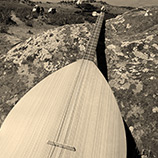 |
|
Saz – (also bağlama) traditional Turkish
seven-stringed plucked instrument with a characteristic,
very long fingerboard and bound frets. Its different
types are popular in also in Iran (setar),
Armenia, Azerbaijan. In a similar form it is known since
the 8th century. It is related to Bulgarian tambura
or Greek bouzouki. The 7 strings are tuned in
octaves, in three groups, for example: 2xG, 2xD and 3xA.
The additional frets may be used to achieve microtones,
which are characteristic to Arabic music. |
|
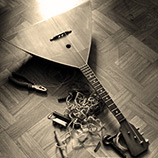 |
|
Bałałajka – (ros. bałabajka)
it’s an instrument from the 17th century, but its tender
sound takes the listener right into the past. The
contemporary bałałajka comes from Russia and Ukraine, it
was taken however from the Tatars or Kazakhs. There are
also alto bałałajkas, as well as bass or even contrabass
versions. All of them became parts of russian national
orchestras. |
|
 |
|
Kobza – during renovation. |
|


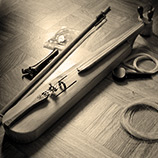 |
|
Kemenche – (tur. kemençe from persian
kamancheh, which means „small bow”) – a string
instrument with three strings, it comes from Turkey,
known also in Greece and Iran pochodzący z Turcji, ale
znany także w Grecji i Iranie. Related to Byzantine
lyre. Today
two variants are popular. The first is a longitudinal
(approx. 55cm) kemenche from the region of the Black
Sea, which you play with a bow (yay) holding the
neck „in the air” with your left hand. The second is
smaller (approx. 40cm) and pear-shaped classical
kemenche (karadeniz kemençesi), which you play
using nail technique, sitting, holding the instrument
vertically on your left knee and chest. Sometimes also
between your knees. The classical kemenche was most
commonly made of one piece of plum wood. Most musicians
played using two strings at the same time, one of them
being a drone string. They used many ornaments, original
harmonies and microtones. |
|
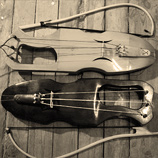 |
|
Jouhikko –
an instrument from the string lira genre, known in
Europe in different variants. This type comes from deep
Scandinavia – Finland. Traditionally its bow and strings
are made of horsehair. The strings are pressed with the
outside of your fingers. Our specimen was made by Łukasz
Hołuj. |
|
 |
|
Maryna – a popular bass instrument from the
northern Wielkopolska. The original is in the Popular
Instruments Museum in Szydłowiec. Our specimen was made
for our order by Tomasz Czypul.
Link
On the other hand, the prototype may be a very unusual
instrument known between the 12th and 18th century: a
2,2 m high Tuba Maryna or Tromba Marina,
Angelic Horn. In France known as Trompette
Marine, in England
as Trumpet Marine, in Germany as Trumscheit,
Marientrompete, Trompetengeige,
Nonnentrompete, Nonnengeige.
Link |
 |
|
Viella – (fr. vielle, ger. fiedel,
en. fiddle, sp. vihuela)
the earliest of the preserved
illustrations and sculptures showing this family of
instruments come from the 10th and 11th centuries.
Viella, in the course of its evolution, replaced the
rebab and along the way with the viola,
became the prototype of today's violins.
Viellas
came in a variety of shapes, from oval, angular to
figure eight-like. Most often
they had 5 gut strings (e.g. d, G, g, d ', d') including
1 drone. In Poland, a similar instrument
from 14th century was discovered in Elbląg. The manufacturer of
our copy of the viella is Hubert Połoniewicz from
Gdańsk.
Link1,
Link
2,
Link 3 |
|


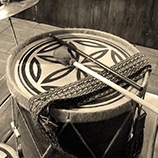 |
|
Baraban – (ros. Барабан) a popular drum
played both hands with drumsticks. Often equipped with a
cymbal. The membrane is made of goat’s skin. Our baraban
is mixed with Panderu – a square hand drum from Morocco, known
also in Galicia and on the Iberian Peninsula. In Morocco
Panderu is used by street musicians as an accompanying
instrument while telling stories. It is played with
fingers, holding it with your both hands above your head
or with a drumstick, when it lies on your knee. Strings
are stretched on its rim, so as to add another tone. |
|
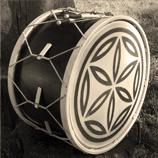 |
|
Davul – a big drum known under various names (tupan,
doli) in Turkey, Iran and almost whole Balkans.
On the bass side it’s played with a wooden drumstick, on
the other with a longer "baton". Its membrane is most
often made with goat’s or sheep’s skin, adjusted with a
rope, pegs or movable leather "beads". Naciąg
najczęściej ze skóry koziej i owczej, regulowany
sznurem, kołkami lub przesuwanymi skórzanymi Our
specimen is 22" in diameter and was made for us by a
German luthier Stefan Pietschmann. |
|
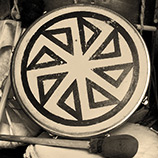 |
|
Drums – frame drums and shamanic drums
with membrane made of goat’s skin. The history of these
drums goes back to the biblical Times, they were known
practically All around the globe and among all cultures.
In hands of a true shaman, it is almost a magic thing. |
|
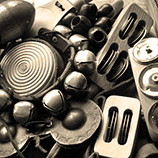 |
|
Other percussions -
including jingles, shakers,
knocker, janissaries – a percussion
instrument in shape of a row of little bells,
originally tied to horse harnesses. In our band,
tied to the drummers ankle, it takes the role of
crash from the drum set. We also have an arabic
type of castanets called kakebs (qraqeb). |
|
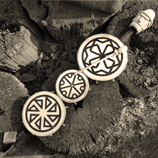 |
|
Bumbas – also known as
ozembuch (Slovakia), pogocello, stump
fiddle, boom-ba, boom bass, hum
strum, stomp stick. A stick with some
percussion stuff, often decorated with a devil’s motive
on its top. In contrast to polish Devilish Violin it doesn’t
have strings.
http://www.stumpffiddle.net/ |
|


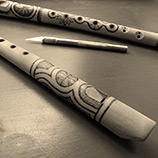 |
|
Recorder – (sp.
flauta, it. fiauto, ger. Flöte,
Fleite, fr. flûte douce) – an
internal duct flute. The oldest representation
of the recorder comes from the area of today’s
France, from the 11th century. The oldest museum
specimen comes from Germany, 12th century. In
contrast to earlier pipes, these are instruments
with a fixed scale and have 9 holes. First
tractates that contain recorder fingerings are:
"Musica getutscht" by Sebastian Virdnung
from year 1511 and Opera institulata
Fontegara by Silvestro di Ganassi from 1535.
Those made of pear wood sound the best. |
|


 |
|
Jew’s-harp – a
steel forged instrument. Its name may have been
twisted from jaw harp. Known for ages from Europe
through Asia, Indochina to Alaska. Our specimen
comes from Ukraine. |
|
|
|
|